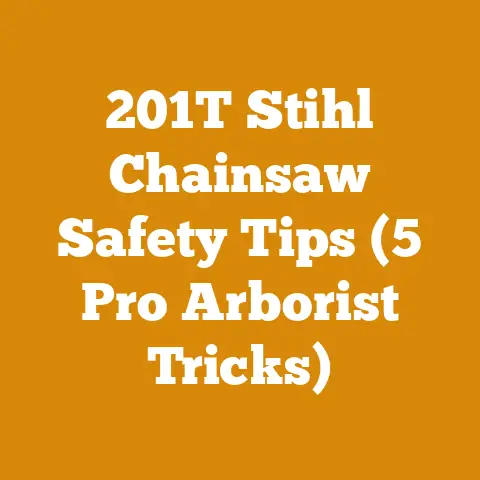Husqvarna 365 Price Guide (5 Pro Tips for Arborists)
For many, the biting chill of winter isn’t just a seasonal inconvenience; it’s a stark reminder of the need for warmth, a need often met by the comforting crackle of a wood-burning fire. But for those of us who depend on wood for heating, or even supplement with it, the journey from standing tree to glowing embers is more than just a simple task – it’s a lifestyle. It’s about self-reliance, connection to the land, and the satisfaction of providing for yourself and your family. It’s a lifestyle I’ve embraced for years, and one that has led me to rely heavily on the Husqvarna 365 chainsaw. I’ve learned a lot in my years of felling trees, splitting logs, and stacking firewood. This guide is about sharing that knowledge, specifically focusing on the Husqvarna 365, a workhorse chainsaw that I’ve come to respect and depend on.
Husqvarna 365 Price Guide: 5 Pro Tips for Arborists (and Serious Homeowners)
The Husqvarna 365 is a chainsaw that strikes a balance between power, weight, and durability, making it a favorite among arborists and serious homeowners alike. Finding the right price and maximizing its potential requires knowing what to look for. This guide will delve into the specifics of the Husqvarna 365, offering insights into pricing, maintenance, and performance optimization.
Understanding the Husqvarna 365: A Technical Overview
Before diving into pricing, let’s understand what makes the Husqvarna 365 a valuable tool. It’s not just a chainsaw; it’s a precision instrument designed for demanding tasks.
Engine Specifications
- Engine Displacement: 70.7 cm³ (4.31 cu. inch)
- Power Output: 3.6 kW (4.8 hp)
- Maximum Power Speed: 9600 rpm
- Idling Speed: 2700 rpm
- Torque, max: 4.0 Nm at 6600 rpm
- Fuel Tank Volume: 0.77 l (1.62 US pint)
- Oil Tank Volume: 0.4 l (0.84 US pint)
- Oil Pump Type: Adjustable flow
- Oil Pump Capacity: 4-20 ml/min
Cutting Equipment
- Recommended Bar Length: 13″ – 28″ (33-70 cm)
- Chain Pitch: 3/8″
- Chain Gauge: 0.058″ (1.5 mm)
- Sprocket Type: Spur 7
- Chain Speed at Max Power: 20.7 m/s
Dimensions and Weight
- Weight (excl. cutting equipment): 6.4 kg (14.1 lbs)
Key Features
- X-Torq® Engine: Reduces fuel consumption and emissions.
- Air Injection™: Centrifugal air cleaning system for longer filter life and reduced engine wear.
- LowVib®: Anti-vibration system that reduces strain on the user’s arms and hands.
- Adjustable Oil Pump: Allows you to control the amount of oil delivered to the chain.
- Magnesium Crankcase: Provides durability and reliability.
These specifications are crucial for understanding the chainsaw’s capabilities and limitations. For example, the recommended bar length is 13″ – 28″, but I’ve found that a 20″ bar is a sweet spot for most tasks, providing a good balance between maneuverability and cutting capacity.
The Price Landscape: New vs. Used
The price of a Husqvarna 365 can vary significantly depending on whether you’re buying new or used, the retailer, and any ongoing promotions.
New Husqvarna 365 Price
- Average Price Range: $700 – $900 USD (as of 2024).
- Factors Influencing Price: Retailer markups, seasonal discounts, included accessories (e.g., extra chains, carrying case).
- Where to Buy: Authorized Husqvarna dealers, online retailers (e.g., Amazon, eBay).
My Experience: I purchased my Husqvarna 365 from a local dealer for $750, which included a spare chain and a bottle of two-stroke oil. Building a relationship with a local dealer can be beneficial for future service and support.
Used Husqvarna 365 Price
- Average Price Range: $300 – $600 USD (depending on condition).
- Factors Influencing Price: Age, condition, hours of use, maintenance history, included accessories.
- Where to Buy: Online marketplaces (e.g., Craigslist, Facebook Marketplace), local classifieds.
Important Considerations When Buying Used:
- Inspect the Engine: Check for excessive wear, leaks, and unusual noises. Start the engine and listen for any knocking or rattling.
- Examine the Bar and Chain: Look for signs of damage, such as bent bars, worn chains, or missing teeth.
- Check the Vibration Dampers: Ensure they are in good condition and not cracked or worn.
- Ask About Maintenance History: A well-maintained chainsaw will last longer and perform better.
- Test Before You Buy: If possible, test the chainsaw before purchasing to ensure it runs smoothly and cuts properly.
My Story: I once bought a used Husqvarna 365 for $350. While it seemed like a great deal, I soon discovered that the engine had significant wear, requiring costly repairs. Lesson learned: always thoroughly inspect a used chainsaw before buying.
Pro Tip #1: Negotiating the Best Price
Negotiating the price of a chainsaw, whether new or used, is an art. Here are some strategies I’ve found effective:
- Do Your Research: Compare prices from different retailers and online marketplaces to get a sense of the average price.
- Be Polite and Respectful: A friendly approach can go a long way in getting a better deal.
- Point Out Any Flaws (When Buying Used): If you notice any issues with the chainsaw, use them as leverage to negotiate a lower price.
- Ask About Discounts: Many retailers offer discounts for cash purchases, military personnel, or first-time buyers.
- Bundle Purchases: Consider buying additional accessories (e.g., chains, oil) along with the chainsaw to negotiate a package deal.
- Be Willing to Walk Away: If the seller is unwilling to negotiate, be prepared to walk away. There are always other options available.
Pro Tip #2: Mastering Chainsaw Maintenance
Proper maintenance is crucial for extending the life of your Husqvarna 365 and ensuring it performs optimally. Here’s a maintenance checklist I follow:
- Daily Maintenance:
- Check the chain tension and sharpness.
- Clean the air filter.
- Check the oil and fuel levels.
- Inspect the bar for wear and damage.
- Weekly Maintenance:
- Sharpen the chain.
- Clean the spark plug.
- Grease the bar sprocket.
- Inspect the anti-vibration system.
- Monthly Maintenance:
- Clean the fuel filter.
- Inspect the fuel lines for cracks or leaks.
- Check the carburetor settings.
- Annual Maintenance:
- Replace the spark plug.
- Replace the fuel filter.
- Have the carburetor professionally tuned.
Technical Details:
- Chain Sharpening Angle: 30 degrees (top plate), 60 degrees (side plate).
- Spark Plug Gap: 0.5 mm (0.020 inches).
- Bar Sprocket Grease: Use a high-quality lithium-based grease.
My Mistake: I once neglected to clean the air filter regularly, which led to reduced engine performance and eventually caused the carburetor to become clogged. Regular maintenance is key!
Pro Tip #3: Optimizing Cutting Techniques
Efficient cutting techniques not only save time and energy but also reduce wear and tear on your chainsaw.
Felling Techniques
- Assess the Tree: Before felling a tree, assess its lean, size, and any potential hazards (e.g., power lines, other trees).
- Plan Your Escape Route: Ensure you have a clear escape route at a 45-degree angle away from the direction of the fall.
- Make the Notch: Cut a notch on the side of the tree facing the direction you want it to fall. The notch should be about 1/3 of the tree’s diameter.
- Make the Back Cut: Cut from the opposite side of the tree, slightly above the bottom of the notch, leaving a hinge of wood.
- Wedge the Back Cut: Use a felling wedge to prevent the tree from pinching the saw bar and to help direct the fall.
Limbing Techniques
- Work from the Base to the Top: Start by removing the lower limbs and work your way up the tree.
- Use the Undercutting Technique: When cutting limbs that are under tension, use the undercutting technique to prevent the bar from pinching.
- Be Aware of Kickback: Always be aware of the potential for kickback, especially when limbing small branches.
Bucking Techniques
- Support the Log: Ensure the log is properly supported to prevent it from pinching the saw bar.
- Use the Over-Under Technique: When bucking logs that are resting on the ground, use the over-under technique to prevent pinching.
- Cut at an Angle: Cutting at a slight angle can help prevent the log from splitting.
Data Point: According to the National Arbor Day Foundation, improper felling techniques are a leading cause of chainsaw-related injuries.
Pro Tip #4: Fuel and Oil Selection
Using the right fuel and oil is critical for the performance and longevity of your Husqvarna 365.
Fuel Recommendations
- Octane Rating: Use gasoline with an octane rating of 89 or higher.
- Ethanol Content: Avoid gasoline with an ethanol content higher than 10%. Ethanol can damage the engine and fuel lines.
- Fuel Stabilizer: Add a fuel stabilizer to prevent fuel degradation, especially if you’re not using the chainsaw regularly.
Oil Recommendations
- Two-Stroke Oil: Use a high-quality two-stroke oil specifically designed for air-cooled engines.
- Mixing Ratio: Follow the manufacturer’s recommended mixing ratio (typically 50:1).
- Bar and Chain Oil: Use a high-quality bar and chain oil to lubricate the chain and prevent wear.
My Experiment: I once experimented with using a lower-grade two-stroke oil, and the result was a significant reduction in engine performance and increased wear. Stick to the recommended oils!
Technical Note: Using the wrong fuel or oil can void the chainsaw’s warranty.
Pro Tip #5: Safety First
Chainsaw operation is inherently dangerous, and safety should always be your top priority.
Personal Protective Equipment (PPE)
- Helmet: Protects your head from falling debris.
- Eye Protection: Protects your eyes from flying debris.
- Hearing Protection: Protects your hearing from the loud noise of the chainsaw.
- Gloves: Protect your hands from cuts and abrasions.
- Chainsaw Chaps: Protect your legs from chainsaw cuts.
- Steel-Toed Boots: Protect your feet from falling logs and chainsaw cuts.
Safe Operating Practices
- Read the Manual: Familiarize yourself with the chainsaw’s operating instructions and safety precautions.
- Maintain a Firm Grip: Always maintain a firm grip on the chainsaw with both hands.
- Keep a Safe Distance: Keep a safe distance from other people and objects when operating the chainsaw.
- Be Aware of Kickback: Be aware of the potential for kickback and take steps to avoid it.
- Never Cut Above Shoulder Height: Cutting above shoulder height is dangerous and can lead to loss of control.
- Never Operate a Chainsaw When Tired or Under the Influence: Operating a chainsaw requires focus and coordination.
Case Study: A local arborist I know suffered a serious leg injury when his chainsaw kicked back while limbing a tree. He wasn’t wearing chainsaw chaps at the time. This incident serves as a stark reminder of the importance of PPE.
Wood Selection Criteria
Choosing the right type of wood for your needs is crucial, whether you’re using it for firewood, construction, or woodworking. Different wood species have different properties that make them suitable for various applications.
Hardwoods vs. Softwoods
- Hardwoods: Generally denser and heavier than softwoods, making them ideal for firewood and construction. Examples include oak, maple, and hickory.
- Softwoods: Generally less dense and easier to work with than hardwoods, making them ideal for construction and woodworking. Examples include pine, fir, and spruce.
Wood Density
- Definition: The mass of wood per unit volume.
- Importance: Affects the wood’s strength, durability, and burning properties.
- Data:
- Oak: 750 kg/m³ (47 lbs/ft³)
- Maple: 700 kg/m³ (44 lbs/ft³)
- Hickory: 830 kg/m³ (52 lbs/ft³)
- Pine: 480 kg/m³ (30 lbs/ft³)
- Fir: 450 kg/m³ (28 lbs/ft³)
- Spruce: 420 kg/m³ (26 lbs/ft³)
Moisture Content
- Definition: The amount of water in wood, expressed as a percentage of the wood’s dry weight.
- Importance: Affects the wood’s strength, stability, and burning properties.
- Ideal Moisture Content for Firewood: 15-20%.
- Ideal Moisture Content for Construction: 12-15%.
- Ideal Moisture Content for Woodworking: 6-8%.
Technical Details:
- Measuring Moisture Content: Use a moisture meter to accurately measure the moisture content of wood.
- Drying Time: The time it takes for wood to dry depends on the species, thickness, and environmental conditions. Generally, hardwoods take longer to dry than softwoods.
My Observation: I’ve noticed that oak firewood takes at least a year to dry properly, while pine firewood can be ready to burn in as little as six months.
Tool Calibration Standards
Proper tool calibration is essential for accurate and safe wood processing. This includes calibrating your chainsaw, moisture meter, and other measuring tools.
Chainsaw Calibration
- Carburetor Adjustment: Adjust the carburetor to ensure the engine is running at the correct air-fuel mixture.
- Chain Tension: Adjust the chain tension to prevent it from being too loose or too tight.
- Bar Alignment: Ensure the bar is properly aligned to prevent uneven wear.
Technical Details:
- Carburetor Adjustment Procedure: Consult the chainsaw’s manual for specific instructions on adjusting the carburetor.
- Chain Tension Adjustment Procedure: Loosen the bar nuts, adjust the tensioning screw, and tighten the bar nuts.
- Bar Alignment Procedure: Use a straight edge to check the bar alignment and adjust as needed.
Moisture Meter Calibration
- Calibration Procedure: Follow the manufacturer’s instructions for calibrating the moisture meter.
- Calibration Frequency: Calibrate the moisture meter regularly to ensure accurate readings.
Measuring Tool Calibration
- Calibration Procedure: Use a known standard to calibrate measuring tools such as calipers and tape measures.
- Calibration Frequency: Calibrate measuring tools regularly to ensure accurate measurements.
Safety Equipment Requirements
Using the proper safety equipment is crucial for preventing injuries during wood processing.
Personal Protective Equipment (PPE)
- Helmet: Protects your head from falling debris.
- Eye Protection: Protects your eyes from flying debris.
- Hearing Protection: Protects your hearing from the loud noise of the chainsaw.
- Gloves: Protect your hands from cuts and abrasions.
- Chainsaw Chaps: Protect your legs from chainsaw cuts.
- Steel-Toed Boots: Protect your feet from falling logs and chainsaw cuts.
Additional Safety Equipment
- First Aid Kit: Keep a well-stocked first aid kit on hand for treating minor injuries.
- Fire Extinguisher: Keep a fire extinguisher on hand in case of a fire.
- Warning Signs: Use warning signs to alert others to the presence of wood processing activities.
Important Note: Always inspect your safety equipment before each use to ensure it is in good condition.
Log Dimensions and Cord Volumes
Understanding log dimensions and cord volumes is essential for accurate wood processing and sales.
Log Dimensions
- Diameter: The diameter of a log is the distance across the log at its widest point.
- Length: The length of a log is the distance from one end to the other.
- Volume: The volume of a log can be calculated using various formulas, such as the Doyle Log Scale, the Scribner Log Scale, and the International 1/4-inch Log Scale.
Cord Volumes
- Definition: A cord is a unit of volume used to measure firewood.
- Standard Cord: A standard cord is 4 feet high, 4 feet wide, and 8 feet long, for a total volume of 128 cubic feet.
- Face Cord: A face cord is 4 feet high and 8 feet long, but the width can vary. The volume of a face cord depends on the width of the stack.
Data:
- Cubic Feet per Cord: 128 cubic feet.
- Typical Log Length for Firewood: 16 inches.
Practical Tip: When stacking firewood, ensure the logs are tightly packed to maximize the volume.
Wood Strength and Drying Tolerances
Understanding wood strength and drying tolerances is crucial for ensuring the wood is suitable for its intended application.
Wood Strength
- Tensile Strength: The ability of wood to resist being pulled apart.
- Compressive Strength: The ability of wood to resist being crushed.
- Bending Strength: The ability of wood to resist being bent.
- Shear Strength: The ability of wood to resist being sheared.
Drying Tolerances
- Checking: Cracks that form on the surface of wood during drying.
- Warping: Distortion of wood during drying.
- Splitting: Separation of wood fibers during drying.
Technical Details:
- Factors Affecting Drying Tolerances: Wood species, drying rate, and environmental conditions.
- Minimizing Drying Defects: Use proper drying techniques, such as air drying or kiln drying, to minimize drying defects.
My Advice: I’ve found that slow, gradual drying is the best way to prevent checking and warping.
Industry Standards and Forestry Regulations
Adhering to industry standards and forestry regulations is essential for sustainable and responsible wood processing.
Industry Standards
- American Lumber Standard Committee (ALSC): Sets standards for lumber grading and sizing.
- Forest Stewardship Council (FSC): Promotes responsible forest management.
Forestry Regulations
- Local Regulations: Check with your local authorities for any regulations regarding tree felling and wood processing.
- State Regulations: Check with your state forestry agency for any regulations regarding forest management and timber harvesting.
- Federal Regulations: Be aware of any federal regulations regarding endangered species and environmental protection.
Important Note: Always obtain the necessary permits before felling trees or processing wood.
Conclusion
The Husqvarna 365 is a powerful and versatile chainsaw that can be a valuable asset for arborists and serious homeowners alike. By understanding its specifications, mastering maintenance techniques, optimizing cutting techniques, selecting the right fuel and oil, and prioritizing safety, you can maximize its potential and ensure its longevity. Remember to always adhere to industry standards and forestry regulations to promote sustainable and responsible wood processing. And always, always put safety first. From my years of experience, I can tell you that taking the time to do things right pays off in the long run.






